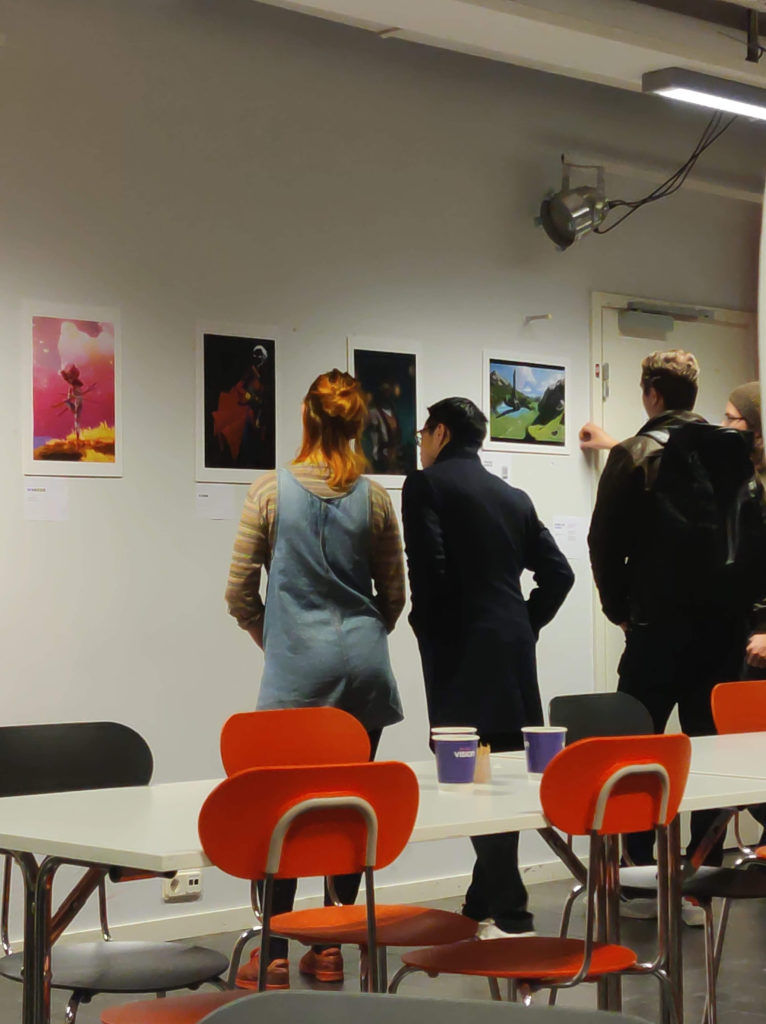“Are you curious about the design process of making digital games?
The culture surrounding video games may be known even for those not instituted in the field, however, the development process is still unknown to the vast majority of people.
The ‘Developer Art Gallery’ is an exhibition where work from the various stages of video game design is presented. The purpose is to demonstrate the artistic and creative process of creating virtual environments and playful narratives.
In this temporary exhibition we present unique pieces from current students enrolled at Södertörns Högskola and Future Games.”
Invitation text for the Developer Art Gallery
The Idea
I was sitting at the dinner table at my mom’s 50th birthday. I was having a very nice conversation with some acquaintances of her who own an art gallery. Later on, as I am talking about my career, I get a frequently asked set of questions: “What? You are a game designer? What does that mean? How do you actually make video games?” As I was describing the work process I had an image in my head, of how one could demonstrate this complex process of making video games… but in the setting of an art exhibition: what it implies, how it is done, the pain and suffering, but also the sense of pride and accomplishment.

The Exhibit
So, with little to no previous knowledge of how to orchestrate an art exhibition I set out to experience many different museums, galleries, art venues, media exhibitions around Stockholm (during the summer). Some about video games, one about the Holocaust, the dance museum was nice, among many other types of exhibits. I took notes of how pieces were placed: in relation to the space (room) and in relation to other adjacent pieces; of how the height of objects and the reflection of light might alter the experience; how an audience with a stroller or walker need more space to move.
I believe there are multiple aspects to the process of media development which are similar to those in traditional art. The tools used in the process might not be the same, since most developers use digital software for production, however there are many cases where developers create inspirational pieces by hand for their team, and for the upcoming game. And it is these pieces that I want to present as art in the Developer Art Gallery.
For the pieces that were presented, I asked friends who study or work in video game development to contribute with one or two of their work(s). In order to increase the amount of pieces I asked students from Södertörns University (Game Development Bachelor’s Programme) and FutureGames if they were willing to contribute to the exhibition with their own existing material. Recruitment was through university communication channels (with permission from head of programmes).

In the end, I managed to gather a total of eleven unique pieces, of which ten where printed and one was analogue. Six of the works included a digital piece for supplementing the printed work. Each selected piece for the exhibit had a purpose, either alone, together with its ‘counterpart’ (digital addition) or together with another printed piece.
Games are about the experience of playful labor. In movies, you are a passive observer, in games you have to be active and engage with the system in order to progress. Thus, the experience I wanted to create was an interactive experience. Each piece had a physical object that was presented (printed images) and some of these had a QR-code attached. If the audience interacted with the piece (by using their smartphones to scan the QR-code) they would be linked to a complementary piece to the one presented (a video of how a piece was made, a demo of programming code, a short video of a game which was presented at the exhibit). I had notes of “how to use QR-codes” printed and placed on multiple places at the exhibit as well as friends and “helpers” who helped the audience with the usage of these.
I did try to gather some sort of budget for the exhibit, in the end I did not manage to find financial support and used my own savings which was actually very little. I originally wanted to have consoles and TV screens for the audience to play or watch the digital pieces next to the printed ones, but I solved it by using the QR-codes and encouraging the audience to use their own phones (since almost everyone uses one now a days), which I believe gave a better result. For the snacks I contacted a local bakery and asked for leftover bread, and got it for free! A friend and I prepared different gluten and lactose-free sauces and toppings for the bread and some additional “not-messy-and-easy-to-eat” snacks. For the installment I asked Södertörns Högskola’s Game Association for help with (wo)manpower to set up the pieces, and I asked the university pub to ‘borrow’ an area for the exhibition. For the prints themselves, I asked an acquaintance who works at a printing shop for assistance (and discount).
All in all, it took me five months for the field research, planning and brainstorming, and an additional seven weeks for organizing the main event. The event lasted one day though 🙂







Contributing Artists:
David Dessantis
Nora Cossa
Erik Forsström
Alexander Lövberg
Frans Flygare
Niki Eriksson
Tobias Årnell
Josefin Strand
Press
Link to a local news article (in Swedish):
Nytt i Flempan / Spelskapandet – en konstnärlig process